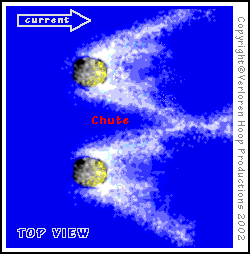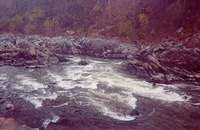Introduction
 Rocks and boulders are the backbone in the formation of many rapids. When the current meeets up with boulders, it behaves differently depending on where it meets the obstruction. Current that hits the boulder head-on backs up and may form a pillow if the surface area is wide. If there is minimal surface area, water quickly escapes along the sides starting eddy lines on both sides of the boulder. The eddy lines diverge further away from each other as you continue downstream. Looking downstream at the water turbulence, it resembles a V pointing upstream. When current passes between two boulders, the eddy lines from each angle towards each other forming a V pointing downstream. The water is often smooth in the middle of this V and we call this a tongue. When the two eddy lines intersect, we often get tail waves. When you have some gradient between the two boulders, the passage way is called a chute. Most of the time, we try to aim for the middle of a chute and ride the smooth water tongue.
Rocks and boulders are the backbone in the formation of many rapids. When the current meeets up with boulders, it behaves differently depending on where it meets the obstruction. Current that hits the boulder head-on backs up and may form a pillow if the surface area is wide. If there is minimal surface area, water quickly escapes along the sides starting eddy lines on both sides of the boulder. The eddy lines diverge further away from each other as you continue downstream. Looking downstream at the water turbulence, it resembles a V pointing upstream. When current passes between two boulders, the eddy lines from each angle towards each other forming a V pointing downstream. The water is often smooth in the middle of this V and we call this a tongue. When the two eddy lines intersect, we often get tail waves. When you have some gradient between the two boulders, the passage way is called a chute. Most of the time, we try to aim for the middle of a chute and ride the smooth water tongue.
The Downstream V
 Rapids are formed by water running over and around rocks and ledges. The most basic feature is the downstream V that develops when water runs between two rocks. This feature is also known as a tongue. Generally, this is what you want to aim for.
Rapids are formed by water running over and around rocks and ledges. The most basic feature is the downstream V that develops when water runs between two rocks. This feature is also known as a tongue. Generally, this is what you want to aim for.
The Upstream V
 The opposite of this feature is an upstream V. In an upstream V, water rushes around a rock. In the previous picture, you can clearly see two upstream V's. In general, we try to avoid upstream V's or at least lean into the rock to avoid capsizing.
The opposite of this feature is an upstream V. In an upstream V, water rushes around a rock. In the previous picture, you can clearly see two upstream V's. In general, we try to avoid upstream V's or at least lean into the rock to avoid capsizing.
Chutes
 Chutes are formed when the river drops between two boulders. Chutes with large drops are called waterfalls or tall ledges. Drops can be more angled as well. Some drops are quite shallow and we call those slides.
Chutes are formed when the river drops between two boulders. Chutes with large drops are called waterfalls or tall ledges. Drops can be more angled as well. Some drops are quite shallow and we call those slides.
